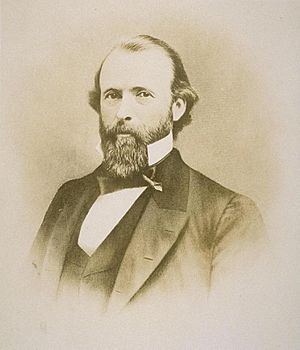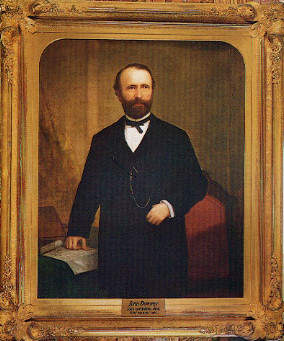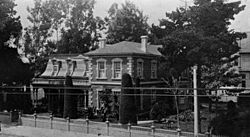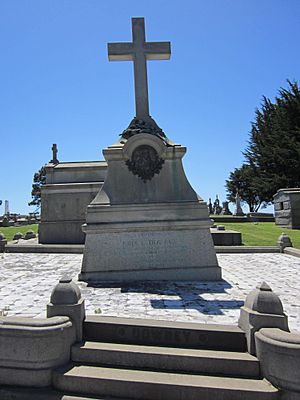John G. Downey facts for kids
Quick facts for kids
John Gately Downey
|
|
|---|---|
 |
|
| 7th Governor of California | |
| In office January 14, 1860 – January 10, 1862 |
|
| Lieutenant | Isaac N. Quinn (acting) Pablo de la Guerra |
| Preceded by | Milton Latham |
| Succeeded by | Leland Stanford |
| 6th Lieutenant Governor of California | |
| In office January 9, 1860 – January 14, 1860 |
|
| Governor | Milton Latham |
| Preceded by | John Walkup |
| Succeeded by | Isaac N. Quinn as Acting Lieutenant Governor |
| Member of the California State Assembly | |
| In office 1856–1857 |
|
| Personal details | |
| Born | June 24, 1827 County Roscommon, Ireland |
| Died | March 1, 1894 (aged 66) Los Angeles, California, US |
| Political party | Lecompton Democrat |
| Spouses | Maria Guirado (d. 1883) Rosa V. Kelly |
| Profession | Apothecary |
| Signature | |
John Gately Downey (born June 24, 1827 – died March 1, 1894) was an Irish-American politician. He served as the seventh governor of California from 1860 to 1862. He was the first governor of California who was born outside the United States, and also the first from Southern California.
Contents
Early Life and Moving to America
John Gately Downey was born in Ireland on June 24, 1827. His family lived in a place called Castlesampson in County Roscommon. When he was 14, in 1842, he and his family moved to the United States. They settled in Maryland, where some of his stepsisters already lived.
Because his family didn't have much money, John had to stop school at age 16. He started working as an apprentice at a pharmacy in Washington, D.C., learning how to prepare medicines. He worked there until 1846.
Starting a Career in California
After his apprenticeship, Downey moved to Cincinnati, Ohio, and worked as a druggist. Like many people during the California Gold Rush, he decided to travel West to California. On his way, he stopped in places like Vicksburg, Mississippi, and New Orleans, Louisiana.
By 1849, Downey reached California. He tried looking for gold for a short time in Grass Valley. Soon after, he found a job at a drug store in San Francisco.
He later moved to Los Angeles. In May 1852, he was elected to the Los Angeles Common Council, which was like the city council, for a one-year term. He was elected again in May 1856 but resigned from the council in December of that year.
Entering State Politics
Downey was a member of the Democratic Party. He was elected to the California State Assembly (part of the state's government) for the 1st District. He served there from 1856 to 1857.
In 1859, Downey was elected Lieutenant Governor of California. This was a big achievement because the Democratic Party was divided at the time. He also won against the new Republican Party.
Becoming Governor of California
Just five days after John Downey became lieutenant governor, the current governor, Milton Latham, resigned. Governor Latham had been chosen to fill a vacant spot in the United States Senate. Because of this, John Downey became the governor of California on January 14, 1860.
During his time as governor, a very important bill called the "Bulkhead Bill" was passed by the state's government. This bill was supported by rich business owners in San Francisco. It would have given private companies control over the city's waterfront. However, many local businesses and people in San Francisco were strongly against it.
Governor Downey surprised many of his wealthy supporters by saying "no" to the Bulkhead Bill. He explained that the bill was unfair and would hurt California's trade and San Francisco's future.
His decision to veto the bill made him very popular in San Francisco and across California. When he visited San Francisco, people cheered for him as a hero. However, those who supported the bill were very angry. Once, a disagreement about the bill even led to a physical argument, which was stopped by Downey's supporters.
The Civil War and Political Changes
In the 1860 presidential election, the Democratic Party split again over big national issues. Downey supported Stephen A. Douglas, who lost to Abraham Lincoln.
When the American Civil War began, Governor Downey said California would support the Union (the northern states). He responded to requests for California troops to help. However, his support for the Union was seen as complicated by some historians. They felt he was still tied to older ideas that had caused the national disagreements.
By the time of the 1861 elections, Downey's popularity had faded. The Democratic Party was still very divided over the issues of the Civil War. Even though Downey had changed his stance on some issues, he didn't get the nomination from his party for governor again. This effectively ended his political career. The Republican Party took advantage of the Democratic split and won the election. Leland Stanford became the next governor.
Life After Being Governor
After his term as governor ended in 1862, John Downey went back to Southern California. He became a successful businessman. In 1871, he helped start the Farmers and Merchants Bank of Los Angeles. This was the first successful bank in Los Angeles, and he founded it with Isaias W. Hellman.
In 1879, Downey also played a key role in starting the University of Southern California (USC). He joined other important citizens, like Judge Robert Maclay Widney, to create the first university in the region. Downey, along with two other community leaders, donated a large amount of land to the university. This land provided space for the campus and helped financially support the new school. Downey Street on the USC campus is named after him.
Later Years and Legacy
In 1883, Downey and his wife, Maria Jesus Guirado, were in a serious train accident. Their train fell into a deep valley. Governor Downey was rescued, but his wife's body was never found. This tragic event deeply affected Downey for the rest of his life.
Later, Downey got engaged to a young writer named Yda Hillis Addis. However, Downey's sisters were not happy about this. They were worried about his wealth if he passed away. They sent Downey to Ireland. Addis later sued him, but she left San Francisco before the trial. Some time after returning to the U.S., Downey married Rosa V. Kelly.
In 1880, Downey bought a very large piece of land called Warner's Ranch in San Diego County. This land was used for raising cattle. In 1892, he tried to remove the Cupeño American Indians who had lived on parts of this land, especially near the hot springs, for a long time. The Cupeño fought this in court, and their case eventually went to the U.S. Supreme Court. However, by the time the court made its decision in 1901, Downey had already passed away. The court ruled that the Cupeño did have a right to the land, but said they had waited too long to make their claim under a specific law. In 1903, the Cupeño people were moved to the Pala Indian Reservation.
John Downey died in 1894 at his home in Los Angeles. He was first buried in Old Calvary Cemetery in Los Angeles. Later, his remains were moved to Holy Cross Cemetery in Colma, California.
The city of Downey, California was named after him. His company owned the land that was divided to create the town in the 1870s.
During Downey's time as governor, construction began on the California State Capitol building in Sacramento. Also, during his governorship, the Pony Express started delivering mail to San Francisco, and the Central Pacific Railroad company was formed.
Images for kids




